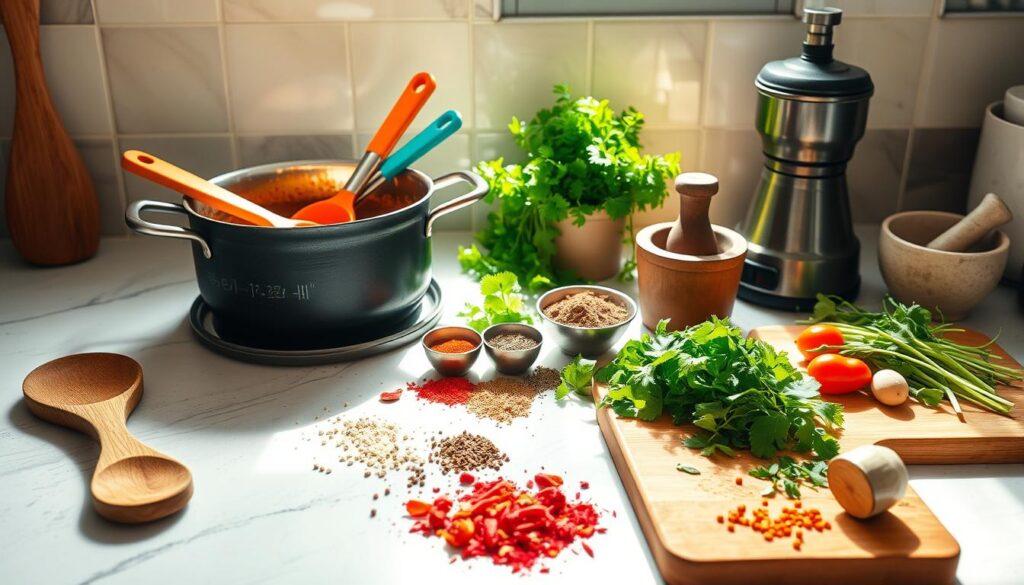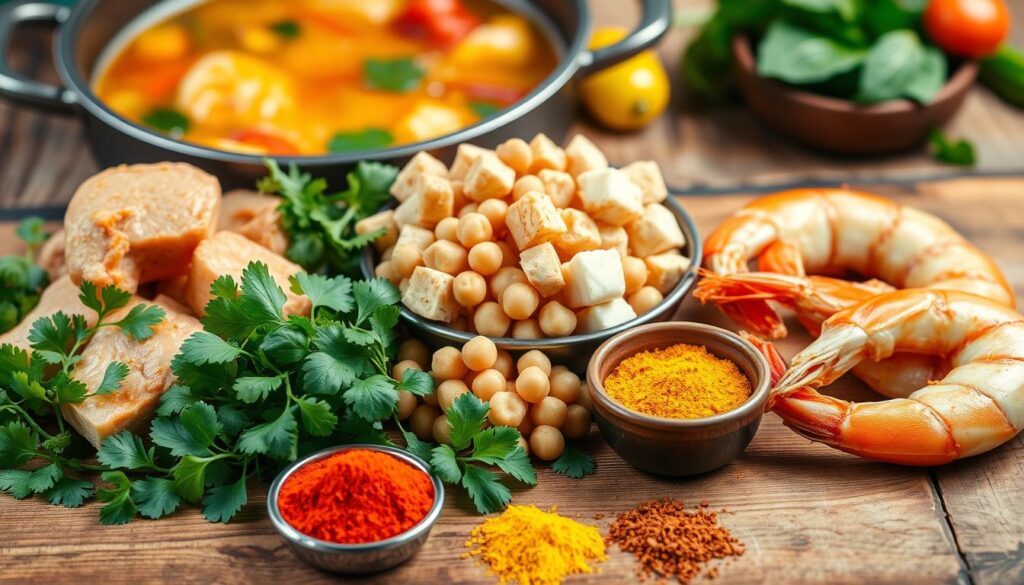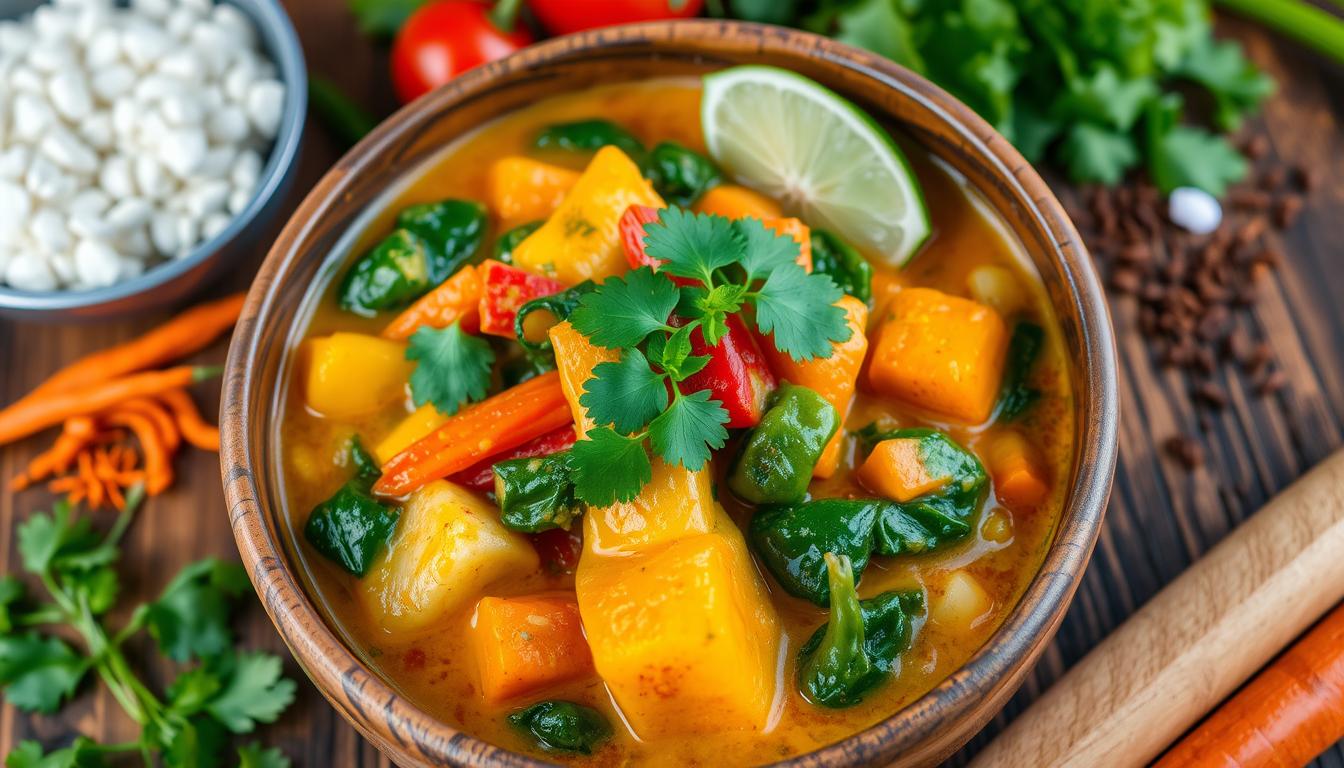Do you want a tasty curry but don’t have time to cook for hours? This easy 30-minute healthy curry recipe is great for beginners and those with busy schedules. It’s a one-pan dish that’s ready in 15-30 minutes, full of flavor and nutrients.
This recipe is flexible, letting you choose chicken or veggies based on what you like and need. With basic ingredients and spices, you can make a delicious, Indian-style meal that’s healthier and quicker than takeout.
If you love curry or are new to Indian flavors, this healthy curry recipe will wow you. It’s quick and simple to make, so you can enjoy a nutritious and beginner-friendly quick curry any time.
Table of Contents
Benefits of Making Your Own Healthy Curry Recipe
Making your own curry is more than just a convenient meal. It’s a way to save money and control what goes into your food. You can make it low-fat, low-carb, or even vegetarian, fitting your diet perfectly.
Nutritional Advantages of Homemade Curry
Homemade curry uses fresh ingredients and less oil than restaurants. This makes it healthier and low-fat. Eating it regularly can boost your digestion, metabolism, and reduce inflammation.
Cost-Effectiveness vs. Takeout
Homemade curry is cheaper than takeout. Buying ingredients in bulk lets you make more for less. This way, you enjoy tasty, homemade curry benefits without spending a lot.
Control Over Ingredients and Portions
When you cook your curry, you pick the ingredients and portion sizes. You can choose lean proteins, add more veggies, and adjust the spice. This lets you make low-fat curry or fit it to your dietary needs, ensuring it meets your health goals.
Essential Ingredients for a Flavorful Curry
Making a delicious spice-infused curry at home begins with the right curry ingredients. Onions, garlic, and ginger are key. They give the curry its savory, pungent taste.
Then, add curry powder or spices like cumin, coriander, and turmeric. These spices make the curry rich and give it a beautiful orange-yellow color. Tomatoes, whether canned or fresh, add a tangy flavor and richness.
Coconut milk or yogurt make the curry creamy. Adding chicken, vegetables, or lentils gives it substance. Bay leaves, cinnamon, and fresh cilantro can also enhance the flavor.
If you like it spicy, add cayenne pepper or fresh chili. Mixing these ingredients makes a flavorful curry that’s both aromatic and tasty.
Kitchen Tools and Equipment Needed
To make a tasty curry at home, you need the right curry cooking tools and kitchen equipment. The ingredients list might look long, but the cookware needed is simple. With the right tools, cooking becomes easier and your curry will taste amazing.
Basic Cookware Requirements
- Large skillet or heavy-bottomed pot with a lid: This is where you’ll simmer your curry.
- Sharp chef’s knife: A good knife helps chop ingredients quickly and evenly.
- Measuring spoons: Accurate spice and seasoning measurements are crucial for a great curry flavor.
- Wooden spoon or spatula: These tools help stir and scrape the pot to avoid burning or sticking.
Optional Equipment for Enhanced Cooking
While basic cookware works, some extra kitchen equipment for curry can make a big difference:
- Garlic press: It makes mincing garlic easy, which is important in many curry recipes.
- Microplane or zester: For grating fresh ginger finely, adding a bright, aromatic flavor to your curry.
- Blender or food processor: Useful for blending ingredients to make smooth, creamy curry sauces.
- Rice cooker: It helps cook fluffy basmati rice, a perfect match for curry dishes.
With the right curry cooking tools and kitchen equipment, you’re ready to become a curry-making pro. Choose quality tools that will last, and enjoy making delicious curries over and over.

Step-by-Step Cooking Instructions
Making a tasty and healthy curry at home is easy, even for beginners. The secret to a great curry is following each step carefully. Let’s explore how to do it:
- Begin by cooking onions, garlic, and ginger. This step brings out the flavors and prepares the dish.
- Then, add your curry powder or spice mix, like cumin, coriander, turmeric, and chili powder. Let the spices toast for a minute or two. This enhances their aroma and taste.
- If you’re using raw chicken or other protein, now is the time to add it. Cook it until it’s done. The protein will soak up the spices, adding flavor to the dish.
- Add your favorite vegetables, like bell peppers, tomatoes, or leafy greens. They bring color, texture, and nutrients to the curry cooking process.
- Next, pour in your liquid, whether it’s broth or coconut milk. Let the curry simmer until the sauce thickens and the veggies are tender. This step blends the flavors and completes the healthy curry recipe steps.
- Finally, add a creamy element, like yogurt or more coconut milk, for a smooth texture.
- Finish with fresh herbs, such as cilantro or parsley, for a bright touch.
The whole curry cooking process usually takes 15-30 minutes. It depends on the protein and how well you like it cooked. With these healthy curry recipe steps, you’ll soon make a delicious and healthy curry.
Spice Selection and Heat Level Guide
Making the perfect curry begins with knowing the spices in curry powder. Curry powder mixes aromatic spices like turmeric, cumin, coriander, and more. You can buy curry powder blends for easy flavor or make your own for a unique taste.
Understanding Curry Powder Blends
The curry’s heat comes from cayenne pepper or hot chilies in the mix. For a milder curry, cut down or skip the cayenne. To make it spicier, add more cayenne or fresh chilies like jalapeños or serranos. Try different mixes to get the flavor and spice just right for you.
Adjusting Spice Levels for Preference
- For a mild curry, use less cayenne pepper or omit it entirely.
- For a medium curry, use the standard amount of cayenne or a mix of cayenne and fresh chilies.
- For a spicy curry, add more cayenne or fresh hot peppers.
Cooking curry at home lets you tailor the spice to your taste. Start with small amounts of spices and adjust until you get your ideal flavor.
| Ingredient | Cost |
|---|---|
| Ground cumin | $1.07 |
| Ground coriander | $0.93 |
| Turmeric powder | $0.50 |
| Ground ginger | $0.27 |
| Mustard powder | $0.07 |
| Cayenne pepper | $0.07 |
| Total cost | $2.90 |
Protein and Vegetable Options
Curry recipes are super versatile. You can try many protein and vegetable options. Whether you want a meaty curry or a vegetarian one, there’s something for everyone.
Protein Choices
Popular proteins for curry include:
- Chicken (both breast and thigh meat)
- Shrimp
- Tofu for a vegetarian or vegan alternative
- Legumes like lentils or chickpeas
For a leaner curry, choose chicken breast or tofu. They are lighter. Shrimp and lentils are also great, healthier choices.
Vegetable Variety
Curries go well with many vegetables. Some favorites are:
- Spinach
- Bell peppers
- Cauliflower
- Peas
- Sweet potatoes
To make a veggie-rich curry, use more veggies and lean proteins. This way, you get a light, tasty dish.
Don’t be afraid to mix different proteins and veggies. This lets you create the perfect curry protein options and vegetable curry for you.
| Protein | Vegetables |
|---|---|
| Chicken (breast or thighs) | Spinach |
| Shrimp | Bell peppers |
| Tofu | Cauliflower |
| Lentils | Peas |
| Chickpeas | Sweet potatoes |

Tips for Achieving the Perfect Curry Consistency
Learning to make a perfect curry consistency is key to better homemade Indian curries. You might want a creamy curry sauce or a velvety texture. These tips will help you achieve curry perfection.
Troubleshooting Common Issues
If your curry is too thin, just simmer it until it thickens. If it’s too thick, add more broth or coconut milk. For a creamy curry, mix in Greek yogurt after cooking stops. This prevents it from curdling.
Making the Sauce Creamy and Smooth
- Use full-fat coconut milk for a rich, creamy curry sauce.
- Blend the onion and tomato base before adding your protein and vegetables for a silky-smooth texture.
- Try different curry powder blends to find the perfect spice mix for your taste.
Follow these tips to master the perfect curry consistency every time. Whether you’re after a comforting creamy curry or a vibrant, smooth curry, you’ll get it right.
Serving Suggestions and Side Dishes
Enjoying a wholesome curry dish is even better with the right side dishes. Classic basmati rice and flavorful naan bread are great options. BBC Good Food has a detailed guide on the best sides for curry. This ensures your meal is a delightful and well-rounded experience.
Try serving your curry over basmati rice or with naan bread for a traditional taste. Cauliflower rice is a low-carb alternative. Pair your curry with cucumber raita, mango chutney, or a fresh salad for a balanced flavor.
Add fresh cilantro, lemon juice, and chopped peanuts for extra crunch. For a heartier meal, try it with steamed broccoli, roasted potatoes, or roasted vegetables. Leftovers can be stored in the fridge for 3-4 days or frozen for 6 months.
| Side Dish | Description |
|---|---|
| Basmati Rice | Fragrant and fluffy basmati rice is a classic accompaniment to curry, offering a neutral base to soak up the flavors. |
| Naan Bread | Soft, warm naan bread is the perfect vessel for scooping up and enjoying every last bite of your curry. |
| Cauliflower Rice | For a low-carb alternative, cauliflower rice provides a healthy and delicious base for your curry. |
| Cucumber Raita | Cool and creamy raita, made with yogurt, cucumber, and spices, helps balance the heat of the curry. |
| Mango Chutney | The sweetness of mango chutney complements the savory flavors of the curry, creating a harmonious blend of tastes. |
Exploring different curry side dishes can make your homemade curry dish even more enjoyable. Try various combinations to find your favorite pairing. Enjoy the flavorful results.
Conclusion
This easy, 30-minute healthy curry recipe is great for beginners and busy people. It’s a nutritious, flavorful meal. By making your own healthy curry recipe, you can choose the ingredients and flavors. This way, you get a dish that’s both tasty and good for you.
The nutritious curry recipe gives you a satisfying meal. It also lets you explore Indian cuisine’s diverse flavors. You can learn about the key ingredients and cooking techniques. Then, you can make this dish at home and try different versions.
Don’t settle for bad takeout when you can make a nourishing, homemade curry. It’s full of nutrients, fiber, and plant-based proteins. Enjoy cooking and make your meals better with this simple yet delicious healthy curry recipe. Bon appétit!

